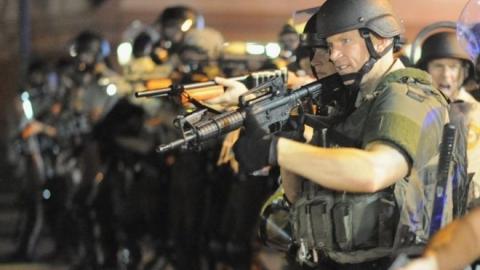Share
Trump and Sessions Make it Easier for Police to Acquire Military Weapons

At a meeting of the Fraternal Order of Police in late-August, Attoreny General Jeff Sessions triumphantly announced the reversal of a President Obama Executive Order intended to limit or restrict access to specific military weapons. The Defense Department program, known as the "1033 Program," was...
...originally for use in drug enforcement by federal and state law enforcement. But in 1997, the program was expanded to include all law enforcement agencies, [and] had resulted in the transfer of more than $5.4 billion worth of surplus military equipment to state, local and tribal law enforcement agencies, to include armored vehicles, riot gear, rifles, ammunition and computers that had been scrapped by the Defense Department.
The action by Trump and Sessions enflames already tense relationships between police and citizens across the country and exacerbates fears of growing authoritarianism and a police-state mentality emanating from the White House.
President Obama's actions to limit the scope of the program came on the heels of the civil unrest following the murder of Michael Brown in Ferguson, Missouri. The Obama administration's order did NOT end the 1033 program, but merely created "lists of 'prohibited equipment' that could no longer be distributed to police and 'controlled equipment' that could only be provided for a demonstrated need."
Backlash to the 1033 program has come from both the right and left, with Senator Rand Paul stating:
“The militarization of our law enforcement is due to an unprecedented expansion of government power in this realm. It is one thing for federal officials to work with local authorities to reduce or solve crime, but it is another for them to subsidize militarization.
And NAACP Legal Defense Fund Associate Director Janai Nelson argued:
“...in the wake of the tragedy in Charlottesville and against a backdrop of frayed relations between police and communities of color further reflects this administration’s now open effort to escalate racial tensions in our country. This action puts more fire power in the hands of police departments that remain largely untrained on matters of racial bias and endangers the public. Inviting the use of military weaponry against our domestic population is nothing short of recasting the public as an enemy.”
The efficacy of distributing military weapons to local police forces has also been challenged by former Justice Department and law enforcement officials.
“The prohibited list is a tiny list of equipment that, honestly, when we talked to law enforcement agencies no one could reasonably defend the use of that equipment. Truly no one,” said Roy L. Austin, a former Justice Department official who worked with Obama’s Task Force on 21st Century Policing. “What we ran into were sheriffs who said we had no right to monitor what they get or how they use what they get, even though they all acknowledged the fact that this was taxpayer-funded equipment. All we were asking for was this: Don’t just acquire the equipment and use it willy-nilly. If you’re going to get it, have a reason.”
Local police are intended to serve as protectors of the public, not enforcers fighting them. The continued militarization of the police, combined with the growing "Constitutional Sheriffs" movement, is a major threat to American democracy and the Constitutional protections of the minority. While we aren't quite on the verge of an all out police state, minimizing the distinction between local police and the military is a step down that path.
